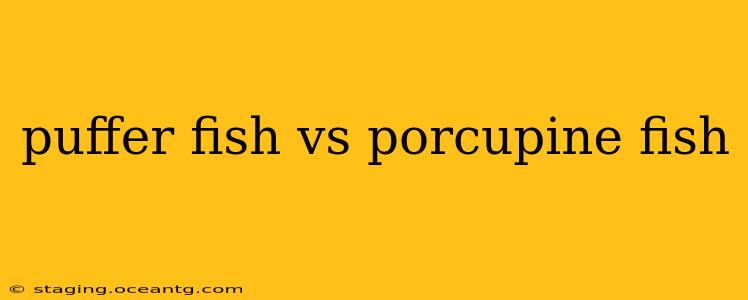Puffer fish and porcupine fish, both belonging to the order Tetraodontiformes, often get confused due to their shared spiny defense mechanism. However, closer examination reveals key distinctions in their appearance, behavior, and even toxicity. This detailed comparison will clarify the differences between these fascinating creatures.
What are the Key Physical Differences Between Puffer Fish and Porcupine Fish?
The most obvious difference lies in how they inflate and the type of spines they possess. Puffer fish, as their name suggests, inflate their bodies into a nearly spherical shape when threatened. Their spines, when present, are usually small and less prominent, often embedded in their skin. Porcupine fish, on the other hand, inflate to a much less dramatic extent, relying more on the rapid erection of numerous long, sharp spines that cover their bodies. These spines are far more visible and formidable than those of puffer fish. Think of a puffer fish's inflation as a "balloon" while a porcupine fish's is more of a "hedgehog."
Furthermore, the overall body shape differs subtly. While both can be somewhat round, porcupine fish tend to have a slightly more elongated body shape compared to the often more compact form of many puffer fish species.
Are Puffer Fish and Porcupine Fish Equally Toxic?
This is a crucial distinction. While some species of both puffer fish and porcupine fish contain tetrodotoxin, a potent neurotoxin, the levels vary significantly. Many puffer fish species are famously known for their extremely high toxicity, making them lethal if consumed improperly. Porcupine fish, while possessing some level of toxicity, are generally considered less toxic than the most venomous puffer fish. However, it's crucial to remember that any consumption of these fish should be strictly avoided unless prepared by an expert familiar with safe handling and preparation techniques. Never attempt to eat a puffer fish or porcupine fish unless you are absolutely certain of its safety.
What are the Behavioral Differences Between Puffer Fish and Porcupine Fish?
Both species share a similar defensive strategy—inflation and spine erection—but their behavioral nuances differ. Puffer fish might exhibit more varied behaviors depending on the species, some being more active swimmers, while others are more sedentary bottom dwellers. Porcupine fish, due to their more formidable spines, tend to rely more heavily on their defensive mechanism and might be less prone to engaging in active foraging in the presence of potential predators.
What Habitats Do Puffer Fish and Porcupine Fish Inhabit?
Both types of fish inhabit diverse marine environments, but their specific preferences can vary. Puffer fish species can be found in various habitats, from coral reefs to estuaries and even freshwater environments. Porcupine fish are predominantly found in warmer waters and are often associated with coral reefs and rocky substrates.
How Do Puffer Fish and Porcupine Fish Reproduce?
Reproductive strategies vary significantly across both groups. Puffer fish exhibit diverse breeding behaviors, some involving elaborate nest construction, while others employ simpler spawning strategies. Porcupine fish breeding behaviors are less widely documented but generally involve external fertilization.
Are There Any Specific Species I Should Know About?
There are numerous species within both puffer fish and porcupine fish families. Well-known puffer fish examples include the fugu (used in Japanese cuisine), while the common porcupine fish ( Diodon hystrix) is a frequently encountered species.
Conclusion: Understanding the Nuances
While both puffer fish and porcupine fish possess spines and inflate as a defense mechanism, their toxicity levels, body shape, spine characteristics, and behavior differ significantly. Careful observation and understanding these distinctions are crucial for responsible interaction and appreciation of these unique marine creatures. Remember, never attempt to handle or consume these fish unless you are a trained professional.
